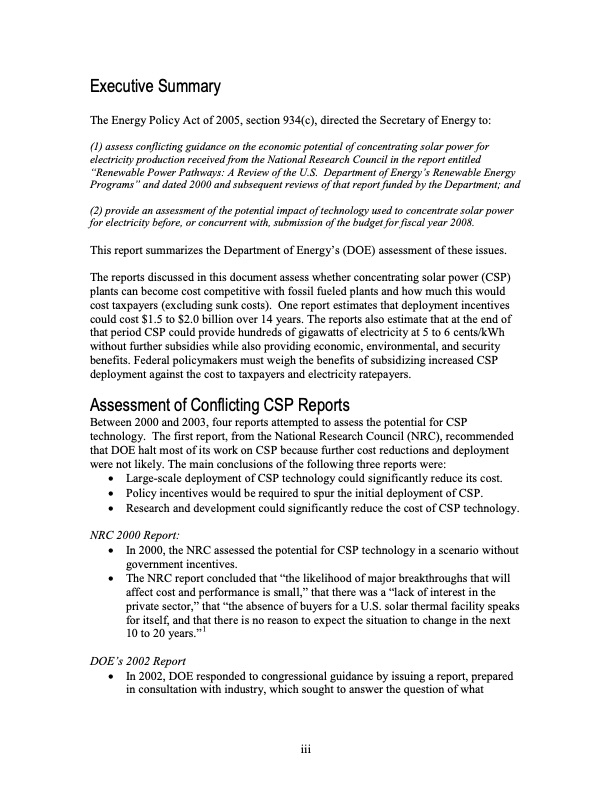
PDF Publication Title:
Text from PDF Page: 003
Executive Summary The Energy Policy Act of 2005, section 934(c), directed the Secretary of Energy to: (1) assess conflicting guidance on the economic potential of concentrating solar power for electricity production received from the National Research Council in the report entitled “Renewable Power Pathways: A Review of the U.S. Department of Energy’s Renewable Energy Programs” and dated 2000 and subsequent reviews of that report funded by the Department; and (2) provide an assessment of the potential impact of technology used to concentrate solar power for electricity before, or concurrent with, submission of the budget for fiscal year 2008. This report summarizes the Department of Energy’s (DOE) assessment of these issues. The reports discussed in this document assess whether concentrating solar power (CSP) plants can become cost competitive with fossil fueled plants and how much this would cost taxpayers (excluding sunk costs). One report estimates that deployment incentives could cost $1.5 to $2.0 billion over 14 years. The reports also estimate that at the end of that period CSP could provide hundreds of gigawatts of electricity at 5 to 6 cents/kWh without further subsidies while also providing economic, environmental, and security benefits. Federal policymakers must weigh the benefits of subsidizing increased CSP deployment against the cost to taxpayers and electricity ratepayers. Assessment of Conflicting CSP Reports Between 2000 and 2003, four reports attempted to assess the potential for CSP technology. The first report, from the National Research Council (NRC), recommended that DOE halt most of its work on CSP because further cost reductions and deployment were not likely. The main conclusions of the following three reports were: • Large-scale deployment of CSP technology could significantly reduce its cost. • Policy incentives would be required to spur the initial deployment of CSP. • Research and development could significantly reduce the cost of CSP technology. NRC 2000 Report: • In 2000, the NRC assessed the potential for CSP technology in a scenario without government incentives. • The NRC report concluded that “the likelihood of major breakthroughs that will affect cost and performance is small,” that there was a “lack of interest in the private sector,” that “the absence of buyers for a U.S. solar thermal facility speaks for itself, and that there is no reason to expect the situation to change in the next 10 to 20 years.”1 DOE’s 2002 Report • In 2002, DOE responded to congressional guidance by issuing a report, prepared in consultation with industry, which sought to answer the question of what iiiPDF Image | 2007 Concentrating Solar Power USA DOE

PDF Search Title:
2007 Concentrating Solar Power USA DOEOriginal File Name Searched:
41233.pdfDIY PDF Search: Google It | Yahoo | Bing
NFT (Non Fungible Token): Buy our tech, design, development or system NFT and become part of our tech NFT network... More Info
IT XR Project Redstone NFT Available for Sale: NFT for high tech turbine design with one part 3D printed counter-rotating energy turbine. Be part of the future with this NFT. Can be bought and sold but only one design NFT exists. Royalties go to the developer (Infinity) to keep enhancing design and applications... More Info
Infinity Turbine IT XR Project Redstone Design: NFT for sale... NFT for high tech turbine design with one part 3D printed counter-rotating energy turbine. Includes all rights to this turbine design, including license for Fluid Handling Block I and II for the turbine assembly and housing. The NFT includes the blueprints (cad/cam), revenue streams, and all future development of the IT XR Project Redstone... More Info
Infinity Turbine ROT Radial Outflow Turbine 24 Design and Worldwide Rights: NFT for sale... NFT for the ROT 24 energy turbine. Be part of the future with this NFT. This design can be bought and sold but only one design NFT exists. You may manufacture the unit, or get the revenues from its sale from Infinity Turbine. Royalties go to the developer (Infinity) to keep enhancing design and applications... More Info
Infinity Supercritical CO2 10 Liter Extractor Design and Worldwide Rights: The Infinity Supercritical 10L CO2 extractor is for botanical oil extraction, which is rich in terpenes and can produce shelf ready full spectrum oil. With over 5 years of development, this industry leader mature extractor machine has been sold since 2015 and is part of many profitable businesses. The process can also be used for electrowinning, e-waste recycling, and lithium battery recycling, gold mining electronic wastes, precious metals. CO2 can also be used in a reverse fuel cell with nafion to make a gas-to-liquids fuel, such as methanol, ethanol and butanol or ethylene. Supercritical CO2 has also been used for treating nafion to make it more effective catalyst. This NFT is for the purchase of worldwide rights which includes the design. More Info
NFT (Non Fungible Token): Buy our tech, design, development or system NFT and become part of our tech NFT network... More Info
Infinity Turbine Products: Special for this month, any plans are $10,000 for complete Cad/Cam blueprints. License is for one build. Try before you buy a production license. May pay by Bitcoin or other Crypto. Products Page... More Info
| CONTACT TEL: 608-238-6001 Email: greg@infinityturbine.com | RSS | AMP |